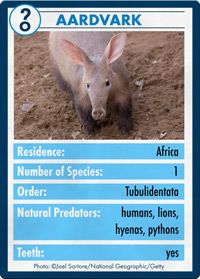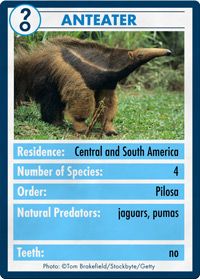Quck answer
Anteaters and aardvarks are two different animals, despite their similar appearance and diet. Anteaters are found in Central and South America, while aardvarks are native to Africa. Anteaters have long, sticky tongues that they use to catch ants and termites, while aardvarks have long, tubular snouts that they use to dig into ant and termite mounds. Anteaters are also known for their bushy tails and sharp claws, while aardvarks have rabbit-like ears and powerful legs for digging. Despite their differences, both animals play important roles in their respective ecosystems as insectivores.
Wild Animals

Termites are a preferred meal for both the aardvark and the anteater.
If you were invited to a potluck dinner with aardvarks, anteaters, and armadillos, you could simply go outside, gather some ants from an anthill, and place them in a bowl for the meal. These animals are part of a group of mammals that enjoy eating ants and termites, which is why they are referred to as myrmecophagous. In fact, only 22 animal species are described as being myrmecophagous [source: Redford].
Anteaters and aardvarks are often thought to be related due to their similar facial features, such as elongated snouts and tongues. The anteater can extend its tongue up to 24 inches (60 centimeters) in order to extract hundreds of ants from anthills. Anteaters can flick their tongues in and out of the hill 150 times per minute [source: Cohn]. This means they can consume up to 30,000 ants and termites in one day [source: San Diego Zoo].
The aardvark’s tongue is about half the length of an anteater’s tongue since its body is generally smaller. However, it is still effective. Both animals have hollow snouts that create suction to help them quickly suck up termites and ants from mounds. Their enlarged salivary glands produce thick, sticky saliva that traps insects on their tongues.
Both species also have powerful olfactory senses that allow them to sniff out their subterranean meals. They use their strong front claws to rip into the mound and begin eating. By striking deeply and quickly into the insect fortresses, they can avoid the wrath of soldier ants that deliver stinging bites.
However, the fact that two animals enjoy the same food and use similar feeding mechanisms does not mean they are related. The anteater and aardvark are examples of convergent evolution, unrelated species that have developed parallel traits in isolation from one another. Both animals are united by their myrmecophagy, but they live on opposite sides of the world. Aardvarks are native to Africa, where they prefer floodplains with water and soft soil for digging. Anteaters are native to Central and South America, where ants thrive in a warmer climate.
Anteaters and Aardvarks: A Nose for Insect Extermination

Joel Sartore/National Geographic/Getty Images

Tom Brakefield/Stockbyte/Getty Images
The animal kingdom’s genetic tree distinguishes anteaters and aardvarks as two separate species. Anteaters belong to the Pilosa order, together with sloths, and have four species of varying sizes. On the other hand, aardvarks only have one species within the Tubulidentata order and are distantly related to elephant shrews.
Anteaters and aardvarks do not have many anatomical similarities, except for their tongues and snouts. Aardvarks are modified ungulates with claws on their forelimbs, while anteaters have paws with large claws and more fur. Anteaters also have a unique way of walking to protect their claws, while aardvarks have teeth that continually grow to withstand the dirt and sand that enter their mouths while rooting around termite mounds and anthills.
The main difference between the two species is found inside their mouths. Aardvarks have teeth, while anteaters have papillae, primitive toothlike protrusions on the roof of their mouths. These papillae help the animals grind up ants, while their muscular stomachs digest the insects. Both species evolved similar mechanisms to follow their preferred diet, but they remain distinctive enough to be considered separate species.
Originally Published: Oct 15, 2008
Aardvark vs Anteater: Frequently Asked Questions
Are aardvarks and anteaters the same?
No, they are not. Although both animals have similar facial features and diets, they live in different regions. Aardvarks can be found throughout Africa, while anteaters are native to South and Central America.
Do aardvarks consume ants?
Yes, aardvarks use their elongated snouts and tongues to locate and eat ants and termites, just like anteaters.
Do anteaters eat ants?
Absolutely. Anteaters are part of the myrmecophagous species, which means they primarily feed on ants.
Do aardvarks have teeth?
Unlike anteaters, aardvarks have teeth that they use to grind and dig in ant and termite mounds. Their teeth continue to grow throughout their lifetime and require natural wear-down.
What’s the daily ant intake for an anteater?
An anteater’s tongue can extend up to 24 inches and pick up nearly 30,000 ants per day.
More Information
Related Articles
- Termites: How They Work
- Edible Bugs: How to Tell
- Wallaby vs Kangaroo: What’s the Difference?
- Penguin vs Puffin: Which is Which?
- Seal vs Sea Lion: What’s the Distinction?
Sources
- Cohn, Jeffrey P. “The Allure of Anteaters.” Americas. November/December 2007.
- “Giant Anteater.” Chicago Zoological Society. (Oct. 2, 2008)http://www.czs.org/czs/Brookfield/Exhibit-and-Animal-Guide/Tropic-World/Giant-Anteater
- Lumpkin, Susan. “Strange Joints: Anteaters, Armadillos and Sloths.” Zoogoer. Smithsonian National Zoological Park. November/December 2007. (Oct. 2, 2008)http://nationalzoo.si.edu/Publications/Zoogoer/2007/6/Strange_Joints.cfm
- “Mammals: Giant Anteater.” San Diego Zoo. (Oct. 2, 2008)http://www.sandiegozoo.org/animalbytes/t-anteater.html
- Mills, M.G.L. and Hes, Lex. “The Complete Book of Southern African Mammals.” Struik. 1997. (Oct. 2, 2008)http://books.google.com/books?id=CavgCweI1nMC
- Myers, Phil. “Tubulidentata.” Animal Diversity Web. 2000. (Oct. 6, 2008) http://animaldiversity.ummz.umich.edu/site/accounts/information/Tubulidentata.html.
- Redford, Kent H. “Curious Creatures to Whom the Ant is La Haute Cuisine.” Smithsonian Magazine. August 1983. (Oct. 2, 2008)http://www.columbia.edu/itc/tc/mstu4031/ch06/pipes/article.txt
- Roy, Tui De. “The Strangest Creature I’ve Ever Met.” National Wildlife Magazine. June/July 2003. (Oct. 2, 2008)http://www.nwf.org/nationalwildlife/article.cfm?articleId=781&issueId=62
FAQ
1. What are anteaters and aardvarks?
Anteaters and aardvarks are both mammals that feed on ants and termites. They are found in different parts of the world: anteaters in Central and South America, and aardvarks in Africa.
2. What do they look like?
Anteaters have long, sticky tongues that can extend up to two feet. They have bushy tails, no teeth, and long snouts. Aardvarks have long, pig-like snouts, sharp claws, and tails that resemble those of kangaroos.
3. How do they differ in behavior?
Anteaters are solitary animals that are active during the day, while aardvarks are nocturnal and tend to be more social. Anteaters are also known for their aggressive defense mechanisms, while aardvarks are more docile.
4. What is their habitat?
Anteaters are found in a variety of habitats, including rainforests, grasslands, and savannas. Aardvarks prefer dry, sandy areas such as deserts, savannas, and scrublands.
5. How do they reproduce?
Anteaters give birth to a single offspring after a gestation period of around six months. Aardvarks have a longer gestation period of seven months and typically give birth to one or two young.
6. What is their lifespan?
Anteaters can live up to 15 years in the wild, while aardvarks have a shorter lifespan of around 10 years.
7. How do they defend themselves?
Anteaters have powerful claws that they use to defend themselves against predators, while aardvarks rely on their sharp claws and the ability to dig into the ground to avoid danger.
8. What is their conservation status?
Anteaters are considered to be of least concern by the International Union for Conservation of Nature, while aardvarks are classified as vulnerable due to habitat loss and hunting.
9. Are they related?
Despite similar diets and appearances, anteaters and aardvarks are not closely related. Anteaters belong to the order Pilosa and are more closely related to sloths, while aardvarks belong to the order Tubulidentata.
10. Can they be kept as pets?
No, it is illegal to keep either anteaters or aardvarks as pets in most countries. They are wild animals that require specialized care and habitat, and can pose a danger to humans.





Leave a Reply